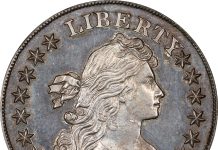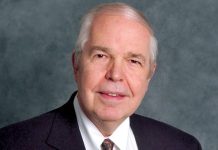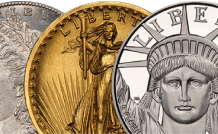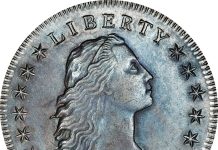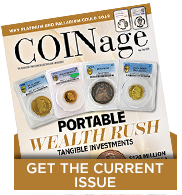BY MIKE GAROFALO
“Innovation is the ability to see change as an opportunity, not a threat.” —Steve Jobs
Americans have always considered our country a nation of boundless innovations and innovators. To celebrate this fact, the United States Senate passed legislation that amended a House of Representatives bill honoring “innovation.” The legislation was named, “American Innovation $1 Coin Act,” and it was sent to President Trump for his signature on July 18, 2018.
The bill mandated a series of dollar coins, limited to four per year, which would be struck commencing in 2018 and ending in 2032. The reverse of each coin would honor “an innovation, innovator, or group of innovators from an individual state or territory.” The obverse of these coins would display the Statue of Liberty (Liberty Enlightening the World). Each obverse will display the motto, “IN GOD WE TRUST” and the denomination of “$1.” The edge of each coin features the year, mintmark and “E PLURIBUS UNUM.”
The very first Innovation Dollar design was, appropriately, one that commemorated President George Washington’s signing into law the very first American patent, which was for a new method of making potash and pearl ash. The program was launched on Dec.14, 2018, but these coins, unlike other “gold dollar” coins, were being released into circulation, as they were only made available in both bag and roll quantity and sold directly by the U.S. Mint on their website (usmint.gov).
Like many coins, these coins were struck at three U.S. Mint facilities, with uncirculated coins being struck in Philadelphia and bearing a “P” mintmark, and in Denver bearing a “D” mintmark. Proof and Reverse Proof coins bear an “S” mintmark, signifying having been struck at the San Francisco minting facility. Like all “Golden Dollars,” these coins are comprised of outer layers of .770 copper, .120 zinc, .070 manganese and .040 nickel bonded to an inner core of pure copper.
The legislation provided for four Innovation Dollar coins to be struck each year, and they will “celebrate innovations and innovators from each of the fifty states, in order of their admission to the Union.” After the introductory coin was struck in 2018, four coins will be struck annually between 2019 and 2032, representing each state, the District of Columbia, Puerto Rico, American Samoa, Guam, the U.S. Virgin Islands and the Northern Mariana Islands. This series will comprise 57 coins in total.
The designs will be selected by the Secretary of the Treasury after consultation with each state or territory governor and the U.S. Commission of Fine Arts. The Citizens Coinage Advisory Committee will review the designs.
The designs are as different as one would expect, which makes for a very interesting series of coins. For example, for the year 2020, there are four unique designs, but they differ greatly in design and topic. One of the coins honors the telephone, as invented by Alexander Graham Bell. The coin was designed by Emily Damstra, a well-known and accomplished coin designer. Dozens of her designs have been minted by the U.S. Mint and the Royal Canadian Mint. Massachusetts wished to honor Bell as many of his experiments were conducted inside of the state. Damstra is a member of the U.S. Mint’s Artistic Infusion Program (AIP), which invites well-known American artists to create designs for coins and medals. This program utilizes the talents of independent artists to enrich and diversify the designs on U.S. Coins.
The coin depicts a rotary dial from a telephone, as most of the early designs Bell might have used or developed would be unrecognizable to people today.
While Massachusetts was choosing an innovation from the World War II era, Maryland chose a more modern innovation to honor. A large telescope to explore space had been a dream for decades. In 1977, Congress approved funding for this telescope for the Goddard Space Flight Center in Greenbelt, Maryland, to be the lead agency for the space observatory. For more than three decades, the Hubble Space Telescope has been giving NASA and the world unparalleled views of the farthest reaches of the universe.
Whether a rotary phone or a space telescope, these innovations have shaped America and kept us in the forefront of modern technology. This interesting coin was designed by Joseph Menna, the current Chief Engraver at the U.S. Mint. Menna has had a lifelong interest in space travel and exploration.
The range of topics covered by these Innovation Dollars is quite dramatic. Rhode Island, not surprisingly, picked a yacht as its innovation. It makes one think of Newport and the America’s Cup races.
Vermont, nestled in snowy New England, chose a snowboarder as the topic for its Innovation Dollar. In the background of that dollar are the Green Mountains, which are truly the playground of Vermont.
One might not think that a simple banjo, a musical instrument that dates back to 17th-century Africa, would be a state’s symbol for innovation. But the banjo was popularized in the 19th century in the American South. Kentucky used the banjo to symbolize “Kentucky Bluegrass” music. This genre of music symbolizes Kentucky. The design was created by U.S. Mint Artistic Infusion Program (AIP) Designer Christina Hess and was sculpted by U.S. Mint Medallic Artist Renata Gordon.
For this year (2025), the states of Arkansas, Michigan, Florida and Texas will have their Innovation Dollar coins launched. Arkansas selected a woman named Raye Montague, an American naval engineer who created the first computer-generated draft of a U.S. Naval ship.
Michigan chose what Detroit was famous for: The coin depicts a 1930s automobile assembly line. That innovation not only changed Detroit, but it also changed how mass manufacturing was done throughout the world.
While Michigan depicted a scene from the 1930s, Florida chose the Space Shuttle. The Space Shuttle is remembered by most people for the Challenger disaster, but the Shuttle Program has concluded 135 missions and all of them launched from Cape Canaveral, in Florida.
Texas chose a space theme as well. It chose to depict an American astronaut taking a spacewalk outside of the International Space Station. All space missions are coordinated and controlled by NASA’s Mission Control, which is based in Houston, Texas. This Space Walk Innovation Dollar was designed by Ron Sanders, an AIP coin designer. It was sculpted by John P. McGraw, a Medallic Artist at the U.S. Mint.
There are numerous other designs coming up for consideration, many of which have not yet been envisioned, as the series will run through 2032. But the unique designs will certainly make for an interesting, diverse and attractive collection.
The U.S. Mint offers these coins in Brilliant Uncirculated and Proof versions. Proof coins come in two different versions: Proof strike on both sides and Reverse Proof coins, where the fields are frosted and the devices are mirrored, which is the opposite of regular proof coins.
The U.S. Mint sells all these Innovation Dollars in roll quantity (25 coins) or in bag quantity (100 coins). The only single coins that are sold by the Mint are Proof coins and Reverse Proof coins.
Single, Brilliant Uncirculated coins and certified examples are available through coin dealers across the United States and on various trading platforms, such as eBay.
This is a notable set to collect, especially for younger people, as they will learn about each state and territory as well as about American innovations and innovators throughout the decades. As the set will not be completed until 2032, it gives collectors a goal to complete. Premiums are relatively low, so the opportunity for completing the collection is extremely high.
My one regret for this entire series is that these coins were not struck for circulation. Since they are not available at banks, in circulation or from vending machines, the overwhelming majority of Americans will never see any of these coins, nor will they be able to appreciate the fact that these coins honor decades of American innovations.
All the children who collected state quarters from circulation with their parents and grandparents will now be forced to buy these coins rather than searching through change to find each of the different coins.
Enjoy collecting these American Innovation Dollars!






